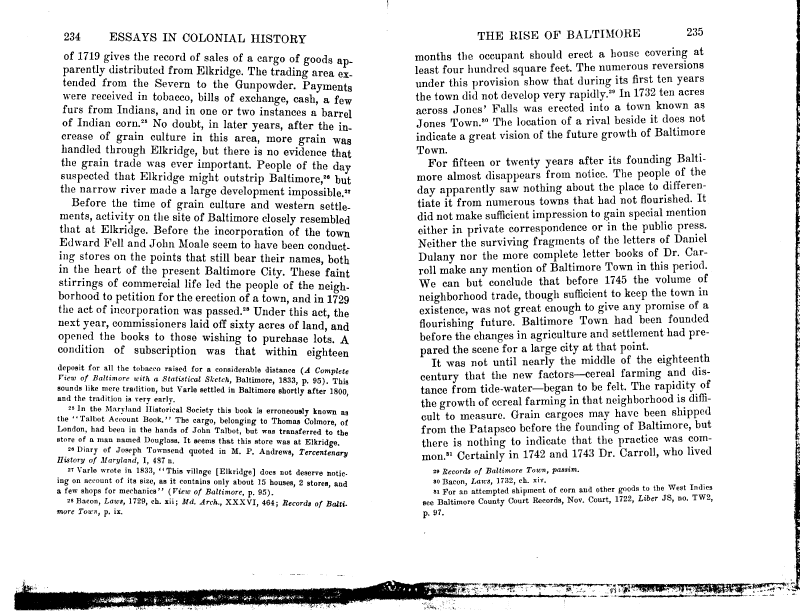|
234 ESSAYS IN COLONIAL HISTORY
of 1719 gives the record of sales of a cargo of goods ap-
parently distributed from Elkridge. The trading area ex-
tended from the Severn to the Gunpowder. Payments
were received in tobacco, bills of exchange, cash, a few
furs from Indians, and in one or two instances a barrel
of Indian corn.25 No doubt, in later years, after the in-
crease of grain culture in this area, more grain was
handled through Elkridge, but there is no evidence that
the grain trade was ever important. People of the day
suspected that Elkridge might outstrip Baltimore,28 but
the narrow river made a large development impossible."
Before the time of grain culture and western settle-
ments, activity on the site of Baltimore closely resembled
that at Elkridge. Before the incorporation of the town
Edward Fell and John Moale seem to have been conduct-
ing stores on the points that still bear their names, both
in the heart of the present Baltimore City. These faint
stirrings of commercial life led the people of the neigh-
borhood to petition for the erection of a town, and in 1729
the act of incorporation was passed.28 Under this act, the
next year, commissioners laid off sixty acres of land, and
opened the books to those wishing to purchase lots. A
condition of subscription was that within eighteen
deposit for all the tobacco raised for a considerable distance (A Complete
View of Baltimore with a Statistical Sketch, Baltimore, 1833, p. 95). This
sounds like mere tradition, but Varle settled in Baltimore shortly after 1800,
and the tradition is very early.
z» In the Maryland Historical Society this book is erroneously known as
the " Talbot Account Book." The cargo, belonging to Thomas Colmore, of
London, had been in the hands of John Talbot, but wag transferred to the
store of a man named Douglass. It seems that this store was at Elkridge.
2s Diary of Joseph Tomisend quoted in M. P. Andrews, Tercentenary
History of Maryland, I, 487 n.
2T Varle wrote in 1833, "This village [Elkridge] does not deserve notic-
ing on account of its size, as it contains only about 15 houses, 2 stores, and
a few shops for mechanics" (View of Baltimore, p. 95).
as Bacon, Laws, 1729, ch. xii; Aid. Arch., XXXVI, 464; Records of Balti-
more Town, p. ix.
THE EISE OF BALTIMORE
235
months the occupant should erect a house covering at
least four hundred square feet. The numerous reversions
under this provision show that during its first ten years
the town did not develop very rapidly.28 In 1732 ten acres
across Jones' Falls was erected into a town known as
Jones Town.80 The location of a rival beside it does not
indicate a great vision of the future growth of Baltimore
Town.
For fifteen or twenty years after its founding Balti-
more almost disappears from notice. The people of the
day apparently saw nothing about the place to differen-
tiate it from numerous towns that had not flourished. It
did not make sufficient impression to gain special mention
either in private correspondence or in the public press.
Neither the surviving fragments of the letters of Daniel
Dulany nor the more complete letter books of Dr. Car-
roll make any mention of Baltimore Town in this period.
We can but conclude that before 1745 the volume of
neighborhood trade, though sufficient to keep the town in
existence, was not great enough to give any promise of a
flourishing future. Baltimore Town had been founded
before the changes in agriculture and settlement had pre-
pared the scene for a large city at that point.
It was not until nearly the middle of the eighteenth
century that the new factors—cereal farming and dis-
tance from tide-water—began to be felt. The rapidity of
the growth of cereal farming in that neighborhood is diffi-
cult to measure. Grain cargoes may have been shipped
from the Patapsco before the founding of Baltimore, but
there is nothing to indicate that the practice was com-
mon.81 Certainly in 1742 and 1743 Dr. Carroll, who lived
2» Records of Baltimore Town, passim.
so Bacon, Laws, 1732, ch. xiv.
si For an attempted shipment of corn and other goods to the West Indies
see Baltimore County Court Records, Nov. Court, 1722, Liber JS, no. TW2,
p. 97.
|

